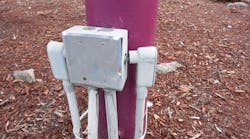How well do you know the Code? Think you can spot violations the original installer either ignored or couldn't identify? Here's your chance to moonlight as an electrical inspector and second-guess someone else's work from the safety of your living room or office. It's your turn to identify the violation.
Hint: Battered and broken
Find the Answer
You can clearly see this installation isn’t holding up very well. The metal LB fitting that separated from the box may have lost its grounding and bonding connection. Without a bonding connection, this could pose a real shock hazard if the LB were to come in contact with an energized conductor since there would not be a low impedance ground fault current path available to trip the circuit breaker supplying power to this circuit.
Section 250.4(A)(3) requires normally non-current carrying conductive electrical equipment to be bonded in a manner that creates a low impedance path for fault current.
Section 314.4 requires metal boxes to be grounded and bonded in accordance with Art. 250.
Section 250.86 requires this low impedance ground-fault current path be established by bonding this box to the equipment grounding conductor run with the circuit conductors.
Any grounding or bonding connections established by connections to the box were lost once this LB became disconnected and separated from the box.
On a different note, I’m also concerned about the use of this cable tie as a means of support for these pipes. According to Sec. 300.6(C)(1), any non-metallic equipment exposed to sunlight must be listed or identified as being sunlight resistant. This may be the wrong application for this cable tie.




